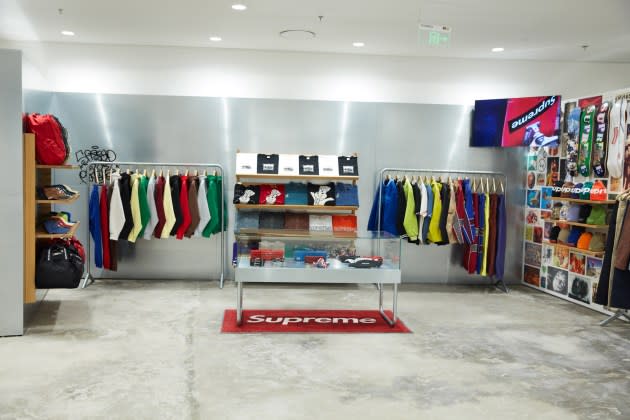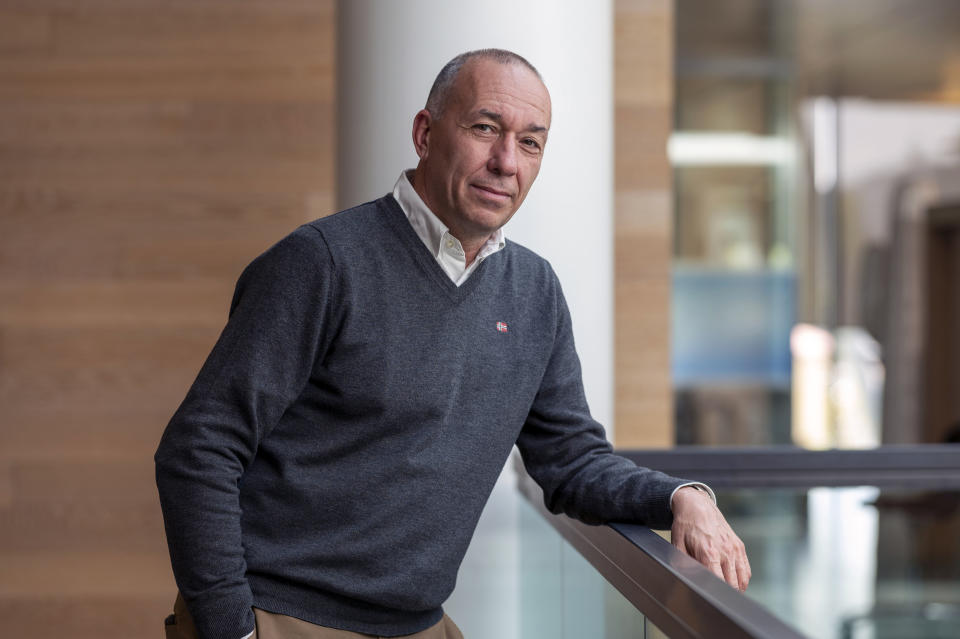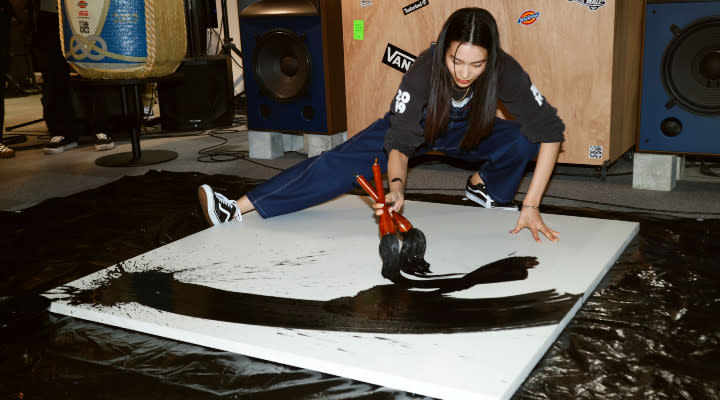VF Corp.’s EMEA and APAC President on Supreme, G-local Design Approach, Continued Innovation

STABIO, Switzerland — Innovation in design, an integrated approach and a g-local mentality are the pillars VF Corp.’s Martino Scabbia Guerrini, executive vice president and president of EMEA, APAC and emerging brands, has embraced over the past few years.
They have ensured VF’s continued growth in the EMEA region, which late last month reported its eighth consecutive quarter of sales increases. Revenues were up 8 percent at constant exchange rates to $901.3 million in the fourth quarter ended April 1.
More from WWD
This compares with an overall decline in VF’s revenues of 3 percent at constant exchange for the quarter to $2.7 billion, dented by the uneven Supreme business, continued sales declines at Vans and an overall weak performance in the Americas.
Although Scabbia Guerrini believes the U.S. will continue to drive global consumption despite inflation and volatility, the EMEA region plays an important role for VF, parent to Timberland, The North Face and Supreme, among other brands.
His goal is to take the same business and design energy eastward in his recently added role of president of the APAC region.
“Europe has been an incremental growth driver for VF but clearly it wasn’t enough….America still accounts for half of sales,” Scabbia Guerrini told WWD, speaking from his office in Stabio, Switzerland, where the company’s EMEA headquarters are based.
“Looking at the past six years more or less, Europe has grown almost always steadily…in the middle double-digit range. We’ve gone through 2016 and the peak of terrorism in Europe, the yellow vest protests in Paris, Brexit and then COVID-19 and now clearly the peculiar economic landscape due to the the Ukraine crisis. There was never a dull and stable period,” he said.
In fiscal 2023, VF’s revenues jumped 12 percent at constant exchange rates in the EMEA region, where the U.K. is the company’s primary market, followed by Germany and Italy. North European countries have emerged stronger after the pandemic, flanking France and Spain.
“I think today what makes a difference is driving performance through the noise, through instability…you need a solid, consistent offering, and interesting, too,” the executive said. “Europe has had the opportunity…to harvest the fruits of the innovative and integrated thinking that we propelled, in addition to brand execution and a strong organization. I think one needs to innovate within the brands by always elevating their level, the level of execution.”
Although VF operates and designs its products with a global customer in mind, there’s a g-local component that has been key in marketing the same values, concepts and design features in different markets.
A focused and premium-leaning distribution has been a key asset and one of Scabbia Guerrini’s top priorities. “It has to be impeccable and increasingly innovative,” he said.
“That’s what Europe did better than other regions within VF and this brought us results because the organization is strong. I think we have talents, strong diversity, as well as business, content and design leaders boasting not only a strategic vision but also a global understanding of consumers, at least on a European level,” he offered.

Transparency, alignment and an integrated approach are core values at VF under Scabbia Guerrini.
“Very often I want data I look at to be accessible to anyone, that market intelligence insights are shared,” he said. “That’s because transparency brings alignment and the latter contributes to clarity on everyone’s tasks. We’re very integrated and tackle business, brand, operational and technology transformation priorities, all at once,” he added.
In fiscal 2023, sales in the APAC region inched up 1 percent at constant exchange and grew 10 percent in the fourth quarter led by a strong performance in Greater China.
“A qualitative approach already bore its fruits in Asia and we have to build on that. It’s not been capitalized on yet [because of stop-and-go retail closures],” he said. Reporting to Scabbia Guerrini, Winnie Ma, president of the APAC region, oversees the local hub in Shanghai, which replaced the former regional unit in Hong Kong.
Scabbia Guerrini sees potential synergies between the two regions stemming from similarities, including the desire for aspirational products and retail spaces.
“It’s evident that Europe and Asia are a reference point for a certain portion of consumers that are forward-looking, seek cultural value in addition to aesthetics, engage by fashion and design interactions, by performance,” he said.
“They have a similar and razor-sharp approach to brands’ segmentation and strong positioning. As much as in Europe, they want a strong design component, and tech innovation and collaborations,” he said mentioning, for example, the integrated e-commerce strategy that in both regions entails the d-to-c channel as well as marketplaces such as Zalando and Tmall, respectively.
The most recent example of an integrated and g-local approach was the introduction of the Tokyo Design Collective, or TDC, in the city’s Harajuku district, a design hub geared at innovation and local fashion.
Compared to VF’s traditional organization structure whereby head design offices, each located in the key geography for the brand, are flanked by regional extensions, Tokyo has only a g-local purpose and is poised to work on individual projects across the company’s brands, with a “local inspiration but global vision,” Scabbia Guerrini said.
“It’s a strategic choice,” he said. “In Japan there’s very specific design, craftsmanship and attention to elevating the heritage of iconic products, and we saw it has a strong impact in terms of influence and trend-building [capability] not only on China, but Europe, too.”

“Having different design hubs spread across the world helps us act faster. The number of drops and stores has increased compared to 10 years ago and [everything] is linked to fashion, trends, culture, arts, collaborations,” he said.
The additional reason for a Tokyo-based design hub is to be found in VF’s brand portfolio, which leans toward streetwear that has a strong resonance in Japan, as the hotbed for creation and influence in the category across the APAC region.
“As China continues to develop its aesthetics and taste, which can easily resonate globally…Japan is gaining back [relevance] when it comes to streetwear,” he explained.
The first drops created by the TDC are to bow next month, standing “at the intersection of streetwear, fashion and communities,” the executive said.
“These are the most important interactions because at the end of the day consumers can be interested in sustainability and discounts — to name things on the opposite end of the spectrum — but ultimately, they are interested in beautiful products, aesthetically pleasant. They want trends, innovation, content and experiences,” he said.
Asia is also a pivotal part of Supreme’s strategy, according to Scabbia Guerrini, who boasted a Supreme-logoed skateboard among his corner office’s decor.
He characterized Supreme, acquired in 2020 for $2.1 billion, as a good summary of the four pillars VF is interested in: powerful brands, elevated designs, a disruptive retail strategy and digital.
“That’s how they are, we acquired them as a brand with a unique operational model and appeal,” he said. “We can learn a lot from it, and it’s not only led by scarcity — that would be banal to say. It’s rather first and foremost built upon the careful construction of communities of core consumers, that are then amplified with a store opening and digital developments,” he said.
“This mechanism was impossible during COVID-19 because of travel bans and store closures, but now it’s back. We have a goal of international expansion,” he said, detailing the reopening of stores in Milan and Berlin, as well as new units in London and Beijing, both inside Dover Street Market.
The latter city marks the trojan horse for Supreme in Asia, where the brand did not have any physical footprint outside Japan. Revamping existing units is also in the pipeline to enhance the customer experience. Overall, the executive noted that the current footprint allows Supreme to reach only 20 percent of target global consumers.
“Moving from that, with our retail strategy we have the potential to double that accessibility rate. However, this should be done with discipline because Supreme is a wonderful model but you need to keep innovating the products, aesthetics and communication. You’d rather avoid oversaturation, the scarcity model…is the tool to remain exclusive,” he said, noting how Europe and Asia are the go-to markets for additional units to bow in the mid-term.
“Today we have a stable portfolio of brands…it’s 12 brands, we’re very focused now, and [the portfolio] is geared at impacting what we think will be relevant for consumers in the upcoming years, the intersection of cultures, streetwear and outdoor, communities…investment on design, possibly responsible design with a strong sustainability component…that’s very clear for VF today,” he said.
Best of WWD

